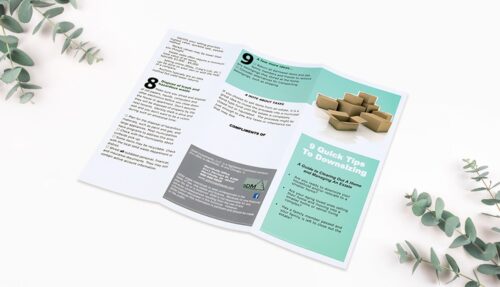A complete guide to creating and using product catalogs to build your brand, promote sales, gather consumer data, target your market, and drive business growth

The product catalog marketing boom
Recent studies indicate that printed product catalogs are experiencing a resurgence in the marketing strategies of both e-commerce and traditional retailers. A large-scale field study published by the Harvard Business Review revealed that incorporating print catalogs led to a 28% increase in sales and a 77% rise in inquiries, yielding a direct return on investment of 600%.
What’s more, the global catalog market, valued at $58.2 billion in 2020, is projected to reach $335.62 billion by 2030, growing at a compound annual growth rate of 20.05%.
This growth underscores the enduring effectiveness of catalogs in engaging consumers and driving sales, even amidst the digital revolution. In short, if you have a product range and you don’t have a product catalog marketing strategy, you could be missing out on a large slice of the profit pie.
The USPS (United States Postal Service) reports a huge growth in product catalog mailing and states that catalogs exercise a more powerful influence on consumer buying decisions than online marketing strategies and television adverts combined.
But before you rush to print your product catalog, you need to know that catalog marketing has evolved and changed over the years. To leverage the potential of catalog marketing today, you must understand the factors, tactics, and strategies that make it so successful. The first question to answer is, what is a product catalog? You may think that the answer is obvious, but think again.
What is a product catalog?
The obvious answer is that a catalog is a list of products with descriptions, prices, and purchase options that’s used to advertise your goods or services. Catalogs are usually mailed to households or distributed in-store. They contain details of purchase options — such as a telephone number to the sales department or an online sales portal — which make it easy for customers to order items listed in the catalog, pay for them, and have them delivered to their door. As far as it goes, that’s all true. But there’s a lot more to it than that.
Contemporary catalogs are more than illustrated product lists. They’re attractive, valuable assets in their own right. They’re expertly designed to represent your brand and unique offer to the consumer; they’re beautifully photographed and printed on high-quality paper stock with expert binding and a stunning cover; and they use powerful storytelling techniques to engage customers, build a consumer community, and increase the emotional value of the products they advertise. A good product catalog will be kept, treasured, shared, and returned to again and again.
The contemporary printed catalog also integrates seamlessly with your digital marketing strategies and sales portals. Consumers can order a physical catalog online, and then move from the catalog to the online sales point to complete a purchase. Discount codes, customer identification, and loyalty schemes can be built in to the catalog experience to gather consumer data, track buying patterns, and measure the ROI (return on investment) of the campaign.
Which businesses profit most from catalogs?
Almost any business, large or small, can make effective use of product catalog marketing. Whether your enterprise focus is on physical products, digital products, or services, with a little creativity, you can make a catalog work hard for your business. Companies who might be attracted to marketing with catalogs could be, for example:
- Mail-order retail businesses — clothes, gardening, furniture, household items, sports goods, toys, outdoor equipment, technology suppliers, etc.
- Direct sales manufacturers — automotive industries, plant machinery makers, construction suppliers, etc.
- B2B technologies — logistical solutions, hardware installations, software manufacturers, etc.
- Agencies and service providers — vacations, trekking companies, experience providers, travel and transport facilitators, etc.
- Creatives and media — artwork, publishers, production and design services, etc.
- Luxury goods retailers — high-end jewelry, watches, fashion, and accessories, etc.
- Food and beverage suppliers — specialty food brands, wine distributors, meal kit providers, and catering services.
- Educational institutions and training providers — schools, universities, and professional development organizations promoting courses, programs, and campus facilities to prospective students and clients.
If your business deals in several large, diverse product lines with complex buying cycles — especially common in the B2B verticals — developing more than one catalog can help organize different sales funnels and more effectively target specific market segments. Catalogs with strong storytelling or thematic elements work well with consumers who like to identify personally with a brand or product style and invest their purchases with significant emotional content — so, creative media, artwork, fashion, and interior design products, for example. If you sell utility products such as tools, machinery, DIY (do-it-yourself) supplies, or technologies, including case studies, testimonials, “how-to” content, and inspirational examples of possible applications can all add value to your catalog and increase customer engagement.

What are the benefits of product catalog marketing?
There are so many benefits to product catalog marketing for almost any business, it’s hard to know where to begin to describe them! Beside the effectiveness of the catalog in generating new sales, engaging customers in long-term, repeat-buying relationships with your brand, and the ease with which you can bring large-scale or unique goods to the attention of the people who are most likely to buy them in the comfort of their own homes, catalogs offer a range of high-value elements in terms of your ongoing business and marketing strategies. For example:
- Measurable response rates and enhanced consumer journey tracking
- Laser-sharp market segmentation and targeting
- Data gathering
- Extended lifespan compared to other forms of marketing, to boost brand visibility and consumer awareness
- High returns on investment
- Powerful lead generation for B2B enterprises
- Increases online engagement and segues with integrated marketing strategies
- Serves as a powerful tool to inform and educate consumers
How to create a product catalog marketing strategy
We’ve already examined the many benefits of catalog marketing. Still, there’s no point pretending that to reap the potential harvest that this kind of marketing strategy offers doesn’t require a significant investment of time, skills, and resources. But as with any enterprise activity, the more you invest in the right assets, the greater your return on the investment over time. When it comes to creating a product catalog and integrating it into your marketing strategy, the old saying “if a job’s worth doing, it’s worth doing well” is very true.
8 steps to success
So, let’s work step-by-step through all the core aspects you need to consider and actions you need to take to research, develop, design, print, and deploy your product catalog so that you have a first-class marketing tool tailored to your business and fueled with quality content that will work hard to boost your brand and swell your bottom line.
Step One: Identify and name your marketing goals
Each catalog is as individual as the business it serves and the aims it is designed to achieve. So, before you can take any further steps, you must spend time clearly defining what you want your catalog to do. That way, you can make it fit for purpose while giving yourself a benchmark against which to measure the results it gives you. You might want your catalog’s primary marketing focus to be:
- build brand recognition
- introduce a new range of products
- break into a new market segment
- boost sales
- drive traffic to your online store
- drive foot traffic to your bricks-and-mortar outlets
- educate and inform your target consumers
- any number of other things!
Of course, your catalog will probably do more than one of these things, but it’s a good idea to give it a central focus or objective. This clarity of focus will help you develop your catalog’s content and style. It will guide you when you choose language and vocabulary; whether to adopt an informal, chatty style or something more formal, for example. It will help you decide on the kind of images and photography to use:
- products against neutral backgrounds
- products in use
- images of people
- ambient contexts
- straight photos or graphically enhanced images
- diagrams and tables
And you’ll need to decide on the balance between text and images. Some catalogs may have very little text. Others may be almost magazine-like and include in-depth articles, interviews, and case studies.
But, in short, before you can begin to design your catalog, you must answer the following three questions in as much detail as possible:
- What’s the primary objective you want your catalog to achieve?
- Who is your catalog aimed at and to whom will it appeal?
- What will you measure to evaluate its effectiveness — sales figures? subscription rates? store visits? web traffic?
Once you’ve answered these questions, you’ll have the information you need to take the next step. The next step is to decide which kind of catalog you need to develop. So, let’s look at the many kinds of catalog from which you can choose.
Step Two: What kind of catalog do you need?
- The full-line catalog. This is, if you like, the “classic” catalog. It’s usually a pretty hefty volume as it’s a comprehensive registry of every product across all ranges; every service and every service level; every purchase and credit option; complete with product descriptions, prices, and a mechanism for direct buying, either via the telephone, online, or through the mail.
- The informational catalog. Catalogs in this category are a form of indirect marketing in that they’re not usually intended to lead to direct sales. Their remit is to provide information about your company, its mission and ethos, and illustrate this with a selection of the products and services you have to offer. The focus of an informational catalog is to educate and build brand awareness, to position your company in the market, evoke curiosity and build trust, and highlight your best products.
- The promotional catalog. Promo catalogs are often time-limited. You use them to draw attention to a sale; perhaps a seasonal price smash, flash sale, or end-of-line discount offer. They’re useful to enhance the visibility of a less popular product line or advertise a new range.
- The service catalog. Imagine a travel agent’s brochure and you have a pretty good idea of what a service catalog is. If your business sells services, experiences, consultancy, and other non-product focused, less tangible offers, the service catalog is the way to go. These are common in the hospitality industry, business-to-business verticals, and consultancy firms. A good service catalog drives inquiries, encourages requests for an initial meeting, and starts the conversation with a potential customer or client.
- The single category catalog. If your company operates across a range of sectors or within an area with several sister and child product lines, you may choose to produce a series of single category catalogs, each tailored to a specific market sector, while still nurturing your overall brand.
Step Three: catalog content checklist
While each catalog’s content will need to be tailored to your business, the marketing aim it’s designed to achieve, the products or services it includes, the target audience, and the action you want them to take, all catalogs must have content which demonstrates a thorough understanding of your products, your target customers and their needs, your unique offer in relation to your core competitors, and the specific value and experience your catalog communicates to the people who read it.
So, before getting down to the detail of the content, be sure to check through this list:
- Have you pulled together all the information you need about each product? What’s the name of the product? What’s it for? Who’s it aimed at? What problem does it solve for the customer? How is it manufactured? Is it quality tested? Do you have testimonials for it from satisfied customers? Are there similar products on the market? What makes yours better?
- Who do you want to read your catalog? Who are they? What sex and gender, if it matters? Where do they live? What’s their social and economic status? Do they already purchase your products? Do they purchase products from your competitors? What are they looking for in your catalog? What ethical values do they bring to their purchase decisions? What action do you want them to take in response to your catalog?
- Who are your top three competitors in your industry, business, or vertical? Do they have catalogs? What are they like? How many? Who are they targeting? Will you try to win their customers or build a new market segment for your brand, product, and offer? What do your competitors do well? Where do they fall down? How can you do better than their best? What will make your catalog stand out from the competition to arouse interest and gain visibility in the marketplace?
Once you’ve got full, detailed answers to these questions and you’ve ticked off each item on this checklist, you’re almost ready to start designing and writing your catalog. Almost, but not quite. First, if you want your catalog to work hard for your business, not only as a sales funnel, but as a powerful market research tool, you should consider building in systems and methods for capturing consumer data, information about how people engage with and interact with your catalog and products, and their purchasing patterns to help you inform, refine, and improve your future product catalog marketing strategy.
Step Four: track and trace in every place
For example, let’s say that a target picks up a copy of your catalog in-store and reads it when they get home. They see a product in the catalog, which is just what they’ve been looking for and the price point is ideal for their budget. So, they go online to your website, browse a little more, and then finally place an order. How can you trace that purchase back to the catalog which originally inspired it? Well, this is where integrated on- and offline marketing tools come into play. Here are several proven tactics for gathering consumer data, tracking buying behavior, and for tracing the consumer journey:
- Quick response codes. If you’ve never come across a QR code, you’re probably a Luddite hermit who lives in a cave! These digital codes are almost ubiquitous these days. We use them to order food, get product information, go to websites, make payments, get tourism deals and advice, access digital museum and gallery guides, and more. Now, if you use QR codes in your printed catalog, a customer can just scan the code with their phone to be taken to the product information page or sales page on your website. What’s more, the code can log the visit and identify it as originating from the paper catalog.
- Response codes. These codes work in a similar way to QR codes, but they’re not automatic and you don’t need a smartphone to use them. It’s a printed code, unique to that catalog, product, or customer, which they can type into a box at the online checkout, dictate or key in over the phone, or copy and take in to a physical store. The code identifies the catalog and the POS (point-of-sale) system logs that information into your database. You can also encourage people to use the codes by linking them to a discount or special offer.
- Personalized uniform resource locators. That’s a bit of a mouth full, so they’re more commonly called PURLs. Despite the long name, it’s a simple concept. It’s just a short code added to the end of a website landing page address (URL) which identifies and logs the consumer and the source of the action. Useful in many situations, PURLs can be expensive and quite complex to set up and manage compared to other options, so make sure you consult with your IT department before committing to this strategy.
- Telesales questionnaire. If your customers make their purchase from the catalog via a good old fashioned telephone call, then the telesales representative can ask them a short questionnaire to identify the catalog, where they got it, and any other marketing information you’re interested in gathering, which they can log directly into the system.
You’ll also want to compare the success of your printed product catalog marketing campaign to other marketing efforts, such as digital, television, in-store, or billboard advertising. So, it’s useful to use a common numerical code system which allows you to compare different data sets and run comparative statistical analyses with the minimum of fuss.
Step Five: create your content and design your catalog
Now you’ve done all your background research, focused your marketing objectives, and decided on a tracking and tracing mechanism, you can finally get on with creating your catalog content and designing the layout and look of the finished product. As your team works on this process, make sure to remember the following important points:
- Use demographic data. Don’t forget all the demographic data that you’ve gathered about your target audience for the catalog. Make sure that the highlighted products and services, along with the language, style, and visual elements of the catalog, are tailored to have maximum appeal for the consumers that you want to get on board with your brand.
- Keep an eye on the competition. While you don’t want to carbon copy your competitor’s catalogs, it’s worth taking into consideration aspects of their content and design which seem to work well. What they do well, do better. What they don’t do well, do well. While you want your brand to stand out from the competition, make sure that it’s still recognizable to your target audience as representing them and the niche or vertical your products and services occupy within the market.
- Design for clear branding. Printed product catalogs are most effective when they are clearly branded throughout the publication. They must be designed with the kinds of color schemes, graphic elements, vocabulary, tone, and style which are appropriate to your target market and will appeal to their tastes and values while impressing your brand on their memory and imagination with positive emotional associations.
- Highlight bestselling goods and services. Build your internal catalog structure around feature pages which highlight your most popular and successful products. You can then use these attractive, attention-grabbing spreads to lead the reader to associated products and services which you’d like to promote.
Step Six: Get a high-quality printing service.
After you’ve gone through the complex and important process of researching, writing, and designing the perfect catalog, make sure that you get the final product printed on high-quality materials by a professional custom offset printer with experience in the field. That’ll be us, by the way!
It’s a good idea to get us involved in your catalog creation process early on. We offer more than just printing services and we have a wealth of knowledge and experience to share and will be happy to work with you on the concept, layout, and design of your finished catalog. Likewise, we can liaise with your designer at each stage of the process.
Once you’ve approved your catalog and your first print run is complete, we cancan send the product to your company base or direct to your mailing service or other distributor. You’re finally ready for your product catalog marketing campaign to begin.
Step Seven: set up distribution channels
Now, there’s no point having a catalog if you’re not distributing it! Getting your beautiful printed catalog out into the world and into the right hands can be a challenge. But there are several proven and effective methods for doing it. Let’s look at them now.
Direct Mail
Direct mailing is still one of the most cost-effective methods of distribution. It can be highly targeted and has proved to have response rates well in excess of online marketing strategies, according to the United States Postal Service (USPS) research. Most people love getting catalogs through the mail and they tend to keep them for weeks at least and to show them to friends, family, colleagues, and associates, too.
POS distribution
The point-of-sale (POS) is an excellent distribution point. After all, you know that the consumer is interested in your brand and products because they’ve just bought something! In-store, have staff offer a free catalog at the checkout. You can also leave catalogs for customers to self-select. Online, give customers the option to request a catalog as part of the checkout process. It can be as simple as checking or un-checking a box.
Ad-driven distribution
You can also advertise your catalog. Traditional print adverts in targeted newspapers and magazines are very effective. So are social media ads on Facebook, Twitter, Instagram, Snap-chat, and others. YouTube, Vimeo, and Dailymotion video channels are also worth exploring.
Step Eight: Gather and analyze your consumer data
Remember that your catalog is more than just a list of products and services and its remit is to do more than make sales. You’ll need to decide the frequency with which you analyze the data that you’re capturing about consumer response to your catalog from telesales, web stores, the high street, and the rest based on the breadth and length of your initial campaign. But that data is powerful information which can help you to refine and improve your future product catalog marketing strategy to get the highest possible return on your investment.
A catalog of successes
Printed catalogs are here to stay. They’re proving themselves to be powerful and efficient marketing tools that offer some of the best returns on investment of any marketing strategy. With the right approach, thorough and comprehensive research and preparation, a skilled creative and design team, and a high-quality custom printer to support the process of producing your catalog, backed up with data capture and analysis to inform the future of your campaign, there’s no reason why your printed product catalog shouldn’t lead your business to a catalog of successes.
Talk to us. We're here to help!
Ready to take your marketing strategy to the next level with professionally designed and printed product catalogs? At QinPrinting, our expert team is here to guide you every step of the way, from concept to completion. Whether you’re looking to elevate your brand, drive sales, or connect with your audience in a meaningful way, we’re ready to help.










